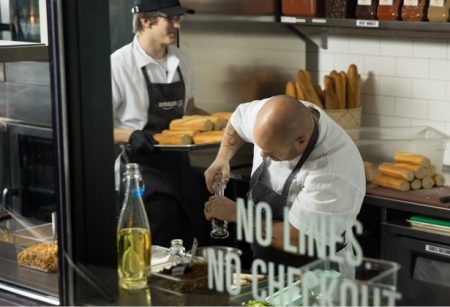December 9, 2016 – In Seattle, Washington, there is a new grocery store that has no checkout counters. Called Amazon Go it stocks basic groceries, meal kits and ready-to-eat foods. When you enter you are given a digital boarding pass Amazon Go app as you walk by a scanner. Your only other requirement is to open an Amazon account on your smartphone.
The store incorporates sensors and computer vision throughout. Every item you pick is tracked. Pick up an item and change your mind about buying it, the store knows all. And it double checks what you take with you before you leave. Everything is charged to your Amazon account. Puts a whole new meaning to the term shoplifting.
This sure beats the automation currently available in supermarkets here in Toronto. Self-service checkouts have popped up in major grocery chains here in Canada, and in the United States, Europe, and Asia. You pick up everything on your shopping list, look at the line ups where there are human cashiers and think why not try the self-service machines where there seem to be far fewer bodies and carts. There are 220,000 of these self-service systems installed in Canada today and that number is expected to grow to over 300,000 by 2020.
Is this an experience that makes shopping more enjoyable, easier, faster, more convenient? Not bloody likely. It seems that these automated systems have little to do with efficiency and everything to do with making the customer-retailer experience far less satisfying.
When I shop I use recyclable bags. Almost every automated checkout system doesn’t really like it when you bring your own bags. And if you don’t have a bag and want to carry the item out “naked” they find it sometimes an impossible transaction to complete. Self-checkout systems ask you to scan every item you want to purchase. Once the scanner logs the item and prices it you take it and put it in a bag that must be placed on a designated surface area. Seems pretty simple until you get to produce like individual apples and other fruit, or vegetables. With no typical bar code to read you are asked to find those sticky little labels applied to your produce (you know the ones you peel off along with some of the skin from your pear or nectarine or apricot) and type the label number on the touch display screen. When something doesn’t scan you have to find the human hovering nearby to figure out why the self-checkout didn’t work. And when you finally finish and go to pay you have to go through a menu of choices before you can finally escape outside.
Every time I use self-checkout, particularly if I have a number of items to buy, when I look back at the human-managed checkout lines it appears to me that my automated experience has taken longer than if I had chosen the human route. That feeling is supported by research done by Marketplace, a Canadian Broadcasting Corporation television show which back in January 2016 explored automation in stores using self-checkout. In their own testing they noted that shoppers with matching lists of items experienced more accurate and faster service using a human rather than a self-checkout machine.
I understand that the self-service automation phenomena is here to stay. After all I more often use an automated teller at a bank then a human. But when my wife and I traveled to Newfoundland back in September I experienced just how pervasive self-serve has become. Upon approaching the check-in counter for our flight I was greeted by rows and rows of machines rather than a human being. These self-check in systems issued boarding passes, baggage tags and processed payments. The only time we spoke to a human attendant was to verify the weight of our check-in bags. Even then I was the one to haul the bag to put it on the belt.
If automation is the way retailers wish us to interact with them now and in the future then I’ll take the Amazon Go experience. Thank you very much. Why? Because self-checkout or check-in so far seems to be a very dehumanizing experience leaving a lot to be desired.












[…] already underway. Over the last few months, up in Seattle, Amazon has established a store called Amazon Go, which is a cashierless retail store for Amazon employees only. The reason it’s only for Amazon […]